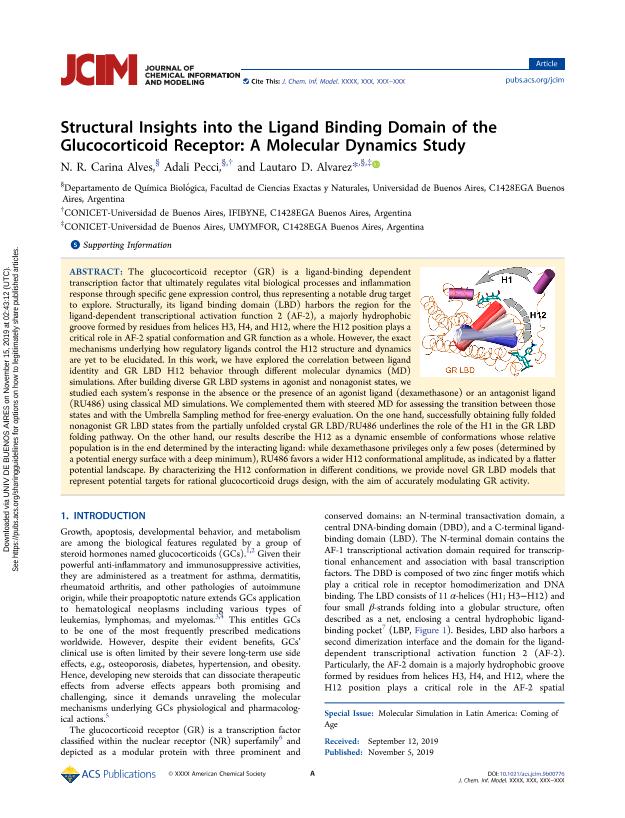Artículo
Structural Insights into the Ligand Binding Domain of the Glucocorticoid Receptor: A Molecular Dynamics Study
Fecha de publicación:
11/2019
Editorial:
American Chemical Society
Revista:
Journal of Chemical Information and Modeling
ISSN:
1549-9596
Idioma:
Inglés
Tipo de recurso:
Artículo publicado
Clasificación temática:
Resumen
The glucocorticoid receptor (GR) is a ligand-binding dependent transcription factor that ultimately regulates vital biological processes and inflammation response through specific gene expression control, thus representing a notable drug target to explore. Structurally, its ligand binding domain (LBD) harbors the region for the ligand-dependent transcriptional activation function 2 (AF-2), a majorly hydrophobic groove formed by residues from helices H3, H4, and H12, where the H12 position plays a critical role in AF-2 spatial conformation and GR function as a whole. However, the exact mechanisms underlying how regulatory ligands control the H12 structure and dynamics are yet to be elucidated. In this work, we have explored the correlation between ligand identity and GR LBD H12 behavior through different molecular dynamics (MD) simulations. After building diverse GR LBD systems in agonist and nonagonist states, we studied each system?s response in the absence or the presence of an agonist ligand (dexamethasone) or an antagonist ligand (RU486) using classical MD simulations. We complemented them with steered MD for assessing the transition between those states and with the Umbrella Sampling method for free-energy evaluation. On the one hand, successfully obtaining fully folded nonagonist GR LBD states from the partially unfolded crystal GR LBD/RU486 underlines the role of the H1 in the GR LBD folding pathway. On the other hand, our results describe the H12 as a dynamic ensemble of conformations whose relative population is in the end determined by the interacting ligand: while dexamethasone privileges only a few poses (determined by a potential energy surface with a deep minimum), RU486 favors a wider H12 conformational amplitude, as indicated by a flatter potential landscape. By characterizing the H12 conformation in different conditions, we provide novel GR LBD models that represent potential targets for rational glucocorticoid drugs design, with the aim of accurately modulating GR activity.
Palabras clave:
Glucocorticoid
,
Molecular mechanism
,
Enhaced sampled methods
,
ligand
Archivos asociados
Licencia
Identificadores
Colecciones
Articulos(IFIBYNE)
Articulos de INST.DE FISIOL., BIOL.MOLECULAR Y NEUROCIENCIAS
Articulos de INST.DE FISIOL., BIOL.MOLECULAR Y NEUROCIENCIAS
Articulos(UMYMFOR)
Articulos de UNID.MICROANAL.Y MET.FISICOS EN QUIM.ORG.(I)
Articulos de UNID.MICROANAL.Y MET.FISICOS EN QUIM.ORG.(I)
Citación
Alves, Norma Roxana Carina; Pecci, Adali; Alvarez, Lautaro Damian; Structural Insights into the Ligand Binding Domain of the Glucocorticoid Receptor: A Molecular Dynamics Study; American Chemical Society; Journal of Chemical Information and Modeling; 60; 2; 11-2019; 794-804
Compartir
Altmétricas




